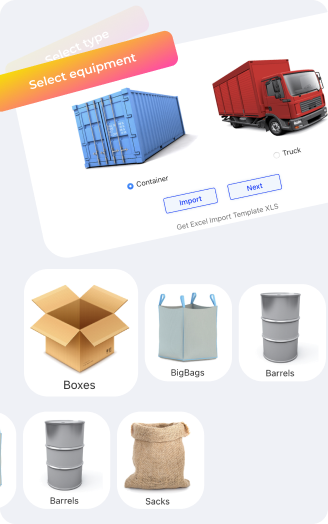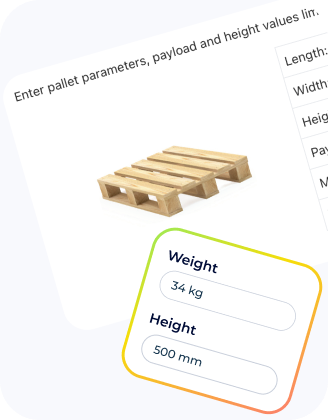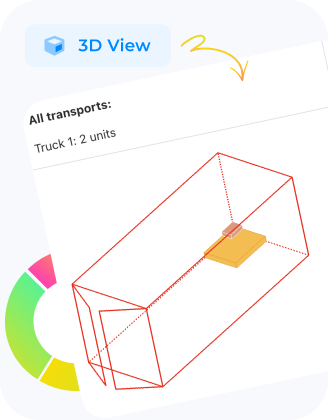About Load Calculator Tool
stuffing
How to do a load calculation for shipping, considering a wide range of packages, containers, and trucks in one place?
-
Easily, with SeaRates cargo loading software it is possible at a glance!
-
Load more cargo than you ever expected due to precise container space and stuffing calculation in this tool.
-
Fast calculate container loading capacity and choose the best one among various cargo loading options for your shipments.
-

-
Extensive functionality
Specify your individual requirements to get a customized approach for loading and packaging. Explore the loading calculator 3D to get a detailed visualization of how to stuff your cargo.
-

-
Easy-to-Use
Step-by-Step load calculator online guide allows you to make the stuffing optimization process more efficient and fast. Whether you need cargo loading ramps or Pallet Load calculations, stuff rollers, big bags, or anything else - you will cope with that easily.
-
Simple integration
The SeaRates load calculation tool is available as a white-label solution directly on your company’s website and as an API integration into CRM/ERP/TMS systems. Include our calculation and processing power of container loading software to promote comprehensive logistics services under your brand.
Contact us -

Quick and effective
Container Load Calculator simulates placing goods inside containers or trucks and determines their optimal positioning within. It’s quite simple: specify the type and cargo dimensions (width, height, length, weight, and number of units). You can pack cargo with the pallet loading calculator feature. The container loading calculator will display the optimal way to position the goods. You can customize the results as you see fit.
It is often used in tandem with Cargo Consolidation Service to figure out how to calculate less than container load (LCL shipment) as profitably as possible. Companies combine it with Trade Platform to help estimate freight quotes for shipping goods internationally.

Customize the position
The 3D container loading calculator provides an interactive scheme to show the optimal positioning of your goods inside a container or truck. It displays the best way to load mixed-size cargo in various packaging into vehicles and containers. The tool comes with a handful of templates for pallets with standard dimensions, weights, and other parameters.
You can customize the position in which your crates, cartons, boxes, or other types of cargo are loaded. This feature is especially important for loading dangerous, fragile, oversized goods.





Your own Load Calculator with language localization
Use or integrate the SeaRates Load Calculator in English, Arabic, German, Spanish, Chinese, and more.
Solicitar un presupuesto de TISeaRates Container stuffing FAQ
-
A 40-foot container has a maximum load capacity of 29 tons (26,300 kg) and an empty weight of around 3,750 kg. It offers approximately 67.7 cubic meters of internal space, making it ideal for large, bulky shipments or high-volume cargo. When planning container loading, this size is perfect for transporting goods like machinery, furniture, or large quantities of smaller items, ensuring efficient use of space while adhering to weight limits.
-
To calculate container loading, measure your cargo’s volume and compare it to the container's capacity (e.g., 67.7 cubic meters for a 40ft container). Ensure the total weight doesn’t exceed the 29-ton load limit. A 3D load calculator can help visualize and optimize space for efficient loading.
-
A container loading plan is a detailed layout showing how goods are arranged within a container to maximize space and ensure safe transport. It helps calculate the optimal way to load cargo based on size, weight, and type of goods. A container loading program or software can automate this process, offering a digital visualization to ensure efficient and secure loading.
-
The cargo loading problem is about maximizing the number of items in a container while staying within weight and volume limits. It focuses on arranging cargo efficiently to avoid wasted space and exceeding capacity. Shippers use tools like container loading programs to find the best arrangement and reduce costs.